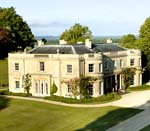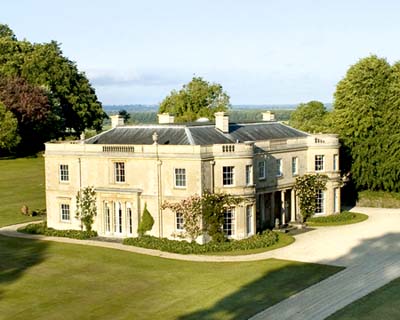The Lushill Estate launches
The exquisite Lushill Estate on theWiltshire-Gloucestershire border has signaled the start of the autumn selling season, says Penny Churchill


The autumn selling season has hit the ground running with the launch, in today's Country Life, of the enchanting, 729-acre Lushill estate between the villages of Hannington and Castle Eaton on the Wiltshire-Gloucestershire border, at a guide price of excess £12 million through Strutt & Parker (020-7629 7282). At the heart of the estate stands Lushill House, an exquisite neo-Georgian country house that looks every inch an 18th-century manor, but is largely a 20th-century creation, built in the early 1960s for its present owner, foxhunting legend Capt Fred Barker.
This part of the north Thames Valley has been prime farming and hunting country for centuries. In the late 1800s, Squire John Archer was ‘the best-known of all the worthies of the Upper Thames Valley... noted for the excellence of his farming and his passionate devotion to foxhunting'. In 1866, he bought the big house on the hill, from which, local records reveal, he ‘could survey the meadows and cornfields, with the busy toilers at work'. He could also hunt ‘three or four days a week' and ‘kiss all the young girls and pretty women, openly and publicly, whatever their status or rank'. This, apparently, he considered to be his prerogative.
Lushill House was built as a two-storey Georgian country villa in about 1797, and later transformed into a grandiose, three-storey, Victorian mansion. John Archer died in 1914, and Lushill was eventually bought by the Cholmeley family, who maintained it in style until 1939. During the Second World War, the mansion housed overseas servicemen, and was subsequently converted into flats. By the time Capt Barker bought the estate in 1962, the once-grand country house was ‘a derelict Georgian-Victorian monster, overgrown by gardens that hadn't been touched since before the war'.
There was already a handsome, four-bedroom, Cotswold-stone farmhouse set next to the main farm buildings, a quarter of a mile or so along the hill from the main house, and it was here that the 27-year-old former 11th Hussar (PAO) and his first wife, Venetia, were to live while Lushill House was being planned and built. Despite having little knowledge of architecture, apart from ‘an interest in columns' acquired on a holiday in Greece, the challenge of re-creating a new Georgian house around the ruins of the old proved irresistible. The architect Thomas Bird, who had worked on Capt Barker's parents' stud farm-King Edwards Place at Wanborough, Wiltshire was commissioned to design and build the new house, with interiors by the postwar prince of decorators, John Fowler.
It took a year to agree the final drawings, and a couple more years to build it, with all the Bath stone cut and shaped on site by local stonemasons. One of the final touches was the traditional inscription on the rainwater heads that reads ‘B [for Barker] 1965'. After careful study of the remnants of the old house, it was decided to retain the eastern end of the building, including the former entrance, two bow windows to the south and north, part of the drawing room and the room beyond it that is now the library.
The rest of the building was demolished, including the entire attic storey. A new main entrance with a striking four-column Ionic portico was created on the north front, along with a new bow window that exactly mirrored the existing one. The symmetry could have been completed by the addition of a further matching bow on the south front, but the owner had had enough of bow windows by then, and the suggestion was firmly rejected. Capt Barker was busy with the farm and ‘couldn't cope with doing the inside', so, once Tom Bird had decided which rooms he wanted, and where, the design and decoration of the interior was left to John Fowler, with tactful supervision by Mrs Barker. Nowhere is Fowler's unique flair for creating classic country-house interiors better displayed than in the drawing room and galleried reception hall of Lushill House.

** Save £1 per issue when you subscribe to Country Life
Exquisite houses, the beauty of Nature, and how to get the most from your life, straight to your inbox.
The drawing room, the largest of five main reception rooms, is flooded with light from the bow window to the north and the glazed double doors of the former main entrance to the east. Enlarged by incorporating the original hall, with an elegant pair of Ionic pillars marking the divide between old and new, 50 years on, the room still has the same silk-lined walls, fittings and furnishings supplied by Fowler, with curtains and carpets by Imogen Taylor.
The galleried reception hall, lit from above by an oval roof lantern, has a simple flagged floor on the ground floor, with a sweeping cantilevered stone staircase at one end; the galleried first-floor landing, which leads to all eight bedrooms, is carpeted in its original Brussels-weave carpet, which today would cost £100 per square foot to replace. Upstairs and down, the walls are still painted in their original apricot, a colour used by Fowler often, and in a variety of shades.
Lushill's wonderful gardens and grounds, which once provided work for nine or 10 gardeners, have been skilfully restored or re-created over the years by Capt Barker's present wife, Penny, with the help of advice and planting expertise from the late James Russell. Formal lawns to three sides of the house are interspersed with mature beds, an ornamental pond and an impressive collection of specimen trees. A second walled garden surrounds an outdoor swimming pool, where the Grecian theme is echoed in the Doric columns and arches that line the sides.
In addition to the main house, the farmhouse, a detached three-bedroom cottage and a terrace of four farm cottages, the estate has an impressive collection of farm buildings on three main sites, comprising former dairy buildings, stores, workshops and an old stable yard. Its 676 acres of farmland, nowadays laid out in large arable enclosures suitable for modern agricultural machinery, have been farmed in hand by the owner, with rotations of wheat, oil-seed rape and barley. The sporting rights are also included in the sale, and it's suggested that the addition of some strategically placed game crops would make it possible to create a ‘modest' shoot over the estate's 700-odd acres of land.
** Save £1 per issue when you subscribe to Country Life
Country Life is unlike any other magazine: the only glossy weekly on the newsstand and the only magazine that has been guest-edited by His Majesty The King not once, but twice. It is a celebration of modern rural life and all its diverse joys and pleasures — that was first published in Queen Victoria's Diamond Jubilee year. Our eclectic mixture of witty and informative content — from the most up-to-date property news and commentary and a coveted glimpse inside some of the UK's best houses and gardens, to gardening, the arts and interior design, written by experts in their field — still cannot be found in print or online, anywhere else.

